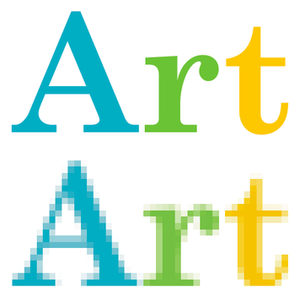
Though on a site only vector images now gather, I consider it necessary to tell about two types of the two-dimensional (2D) computer graphics in general: vector (vector) and raster (bitmap). Without having investigated the basic distinctions between them it is almost impossible to begin work with a computer graphics. The raster image is the grid of separate points (pixels) where each pixel can be other colour or a shade is used. In the vector graphics the image is described by points and vectors (pathes) which are connected among themselves by mathematical formulas.
Let's consider an example: a word "Art" above in a vector variant and below - in raster. For more clear the image was scaled up in 6 times. The raster image become jagged with visible transitions of colours at borders of letters while the vector image remains smooth. Everything is explained by structure of a raster drawing. Smoothness of color is achieved by "blurring" of neighboring pixels - for them is given a colors. Thus, than there are more pixels and they are smaller, the raster image will be more quality. They require a high-resolution computer peripherals and special methods of smoothing to look smooth. That's why files with quality raster images have the big size. Vector graphics are mathematically described and looks smooth at any size and resolution. And almost no file size depends on image size. And the size of a file does not depends on the image size.
In the history of computer technics appears very much formats of graphic presentation. As vector and raster. Below is a most popular of them.
The most popular vector formats:- CDR (CorelDRAW)
- CMX (Corel Exchange)
- SVG (Scalable Vector Graphic)
- AI (Adobe Illustrator)
- CGM (Computer Graphics Metafile)
- DXF (AutoCAD)
- WMF (Windows Metafile)
The raster graphics is better to use for photos, images with small elements and wide colour gamut. The vector graphics is ideal for publishing, line-art, technical drawings and illustrations. There are meta-format, which allowed both raster and vector graphics. Then all the advantages of a vector graphics are limited by embedded raster elements.
Note that vectors easily and without loss of quality is increasing or decreasing, it is always possible to convert in a bitmap of any size, while the raster image is difficultly scaled in general and even more difficult to transform it into the vector. It is interesting that the vectors in the mathematical representation actually exists only virtually in the file. And it always turns into a bitmap for print or output to the monitor. There is a special applications - graphic editors. Converting between bitmap formats easy, but do not forget about formats compatible in color gamut, resolution etc.
The most popular vector graphic editors: The most popular raster (bitmap) graphic editors: Let's sum up:The raster graphics suitable for storing high-quality photorealistic images; consists of separate dots - pixels; always through a rectangular pixel structure; supports limited transparency; really depends on the resolution; easily converted to other raster formats; scaling reduces quality of image.
The vector graphics is used for illustrations and technical drawings; easily scaled; resolution independent; can be any shape; excellent support of a transparency; it is difficult for reproduction of photorealistic images.


Leave a Comment